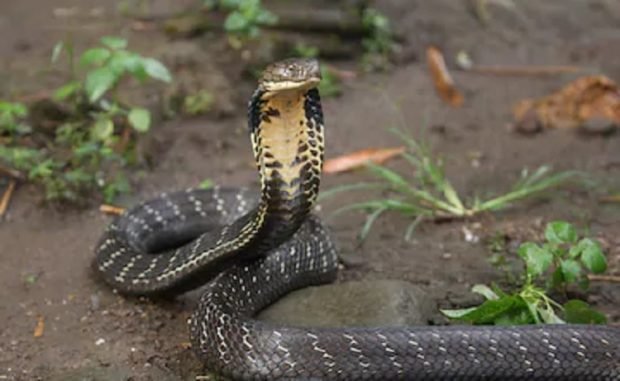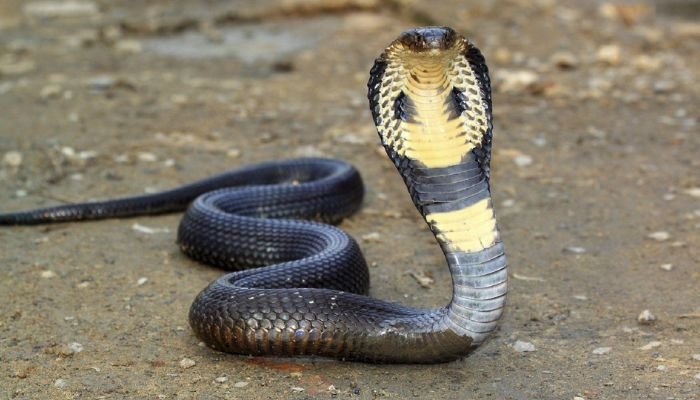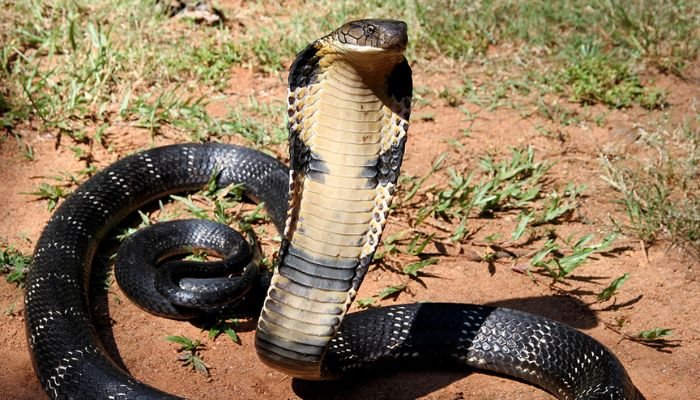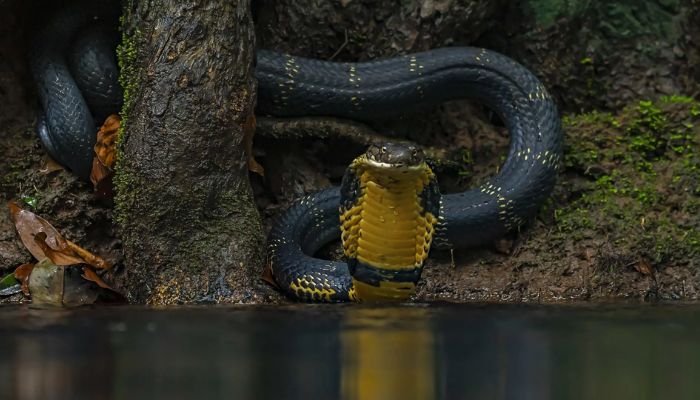
The magnificent and extremely lethal King Cobra is an awe-inspiring and intriguing species of snake. This incredible reptile, which is the world’s longest venomous snake, can develop up to 18 feet in length. The King Cobra’s hood, which it extends when threatened or behaving aggressively, is easily recognizable. This snake, native to the forests of Southeast Asia, preys primarily on other snakes, including venomous species, and its neurotoxic, lethal venom is a formidable weapon.. Here are King Cobra Guide on Food, Habitat, Size, Lifespan & Predators below-
King Cobra Stats in Table format
The stats are given below for King Cobra
| Reptiles List | King Cobra |
|---|---|
| Family | Elapidae |
| Type | Snake |
| Size | Large |
| Length | King Cobra: Up to 10-18 feet (3-5.5 meters) |
| Color | King Cobra: Typically has a uniform olive-brown to dark brown or black coloration. |
| Weight | King Cobra: Adult King Cobras can weigh between 10 to 20 pounds or more.. |
| Lifespan | 20-30 years (or more) |
| Reproduction | Oviparous, lays eggs |
| Gestation Periods | Approximately 6-9 months |
| Endangered Status | Vulnerable (IUCN Red List) |
| Features | Large size, hood when threatened, potent venom |
| Country & Areas | India, Southeast Asia, Indonesia, Malaysia, Thailand, Myanmar, Cambodia, Laos, Vietnam, Philippines, Singapore, and southern China. |
King Cobra Natural Habitat and Distribution:
The King Cobra is native to the jungles and tropical woods of Southeast Asia, where it is widely distributed across countries including India, Indonesia, Malaysia, and the Philippines. They are well-adapted to a wide variety of habitats, from tropical forests to grasslands, and have been spotted as far below sea level as 2,000 meters above it. Vegetation offers these snakes with cover and easy access to their favorite prey, which is why they favor it. King cobras are a fearsome species that have a large ecological impact due to their widespread natural distribution and the fact that they have adapted to a variety of habitats.
King Cobra Physical Features and Adaptations:
Here are some information on King Cobra:-
Body Structure:
The King Cobra is the longest-known deadly snake due to its remarkable physical composition. Male King Cobras are typically larger than females, however, both sexes can grow to be as long as 18 feet (5.5 meters) when fully grown. Their slim, streamlined bodies help them maneuver quickly and easily through thick vegetation. The King Cobra is unique among venomous snakes in that it has a hood-like structure on its neck that it can expand when it feels threatened. This alarming behavior serves to scare off prospective enemies by making the snake look bigger and more powerful.
Coloration and Patterns:
King Cobras’ colour varies widely across geographic ranges. Olive or brown forms the bulk of their coloring, while lighter or yellowish streaks run the length of their bodies. The King Cobra’s hood is usually a lighter hue than the rest of its body, and it has a striking black pattern. This snake’s camouflage and natural ability to blend into its surroundings make it a deadly ambush predator.
Defense Mechanisms:
The King Cobra has several techniques of self-defense, which aid in its survival in the environment. Its deadly bite is its most distinctive feature. The neurotoxic venom of the King Cobra paralyzes its victim and protects the snake from predators. When confronted, a snake will at first try to flee but will eventually raise its body, spread its hood, and hiss loudly to scare away potential enemies. The King Cobra’s intimidating appearance and deadly venom make it a formidable foe among the animal kingdom.

King Cobra Diet and Feeding Habits:
Here are some information on King Cobra:-
Diet Type:
The King Cobra, which is venomous and non-venomous alike, is a member of the Elapidae family and a predatory predator. Its primary diet is snakes, but it also eats lizards, birds, rodents, and even small mammals on occasion. The King Cobra is the apex predator in its ecosystem, regulating the numbers of many different types of prey animals.
Preferred Food Sources:
The King Cobra feeds mostly on snakes, and prefers to consume other venomous snakes such as pit vipers and vipers. The King Cobra’s immunity to the venom of other snakes makes it possible for it to eat other dangerous species without worrying about being poisoned itself.
Feeding Schedule:
King cobras are not routine eaters like other snakes; instead, they hunt whenever the opportunity presents itself. They eat as often as their metabolism requires and as often as prey is available in their environment. In times of food scarcity, they are able to eat massive amounts of food and then go for days or even weeks without eating again.
King Cobra Housing and Enclosure Requirements:
Here are some information on King Cobra:-
Terrarium Size and Setup:
Due to their hazardous nature and unique care requirements, King Cobras are not appropriate as pets. They need massive, one-of-a-kind cages that are an exact replica of their original environment to thrive in captivity. Such cages should be sturdy enough to prevent escape and well-ventilated enough to reduce tension and noise levels inside.

Substrate Options:
The substrate in the terrarium should look like a forest floor, so the snake has somewhere familiar to dig or slither. Substrates like coco coir, cypress mulch, or a blend of organic soil and sphagnum moss work well.
Temperature and Lighting:
The health and well-being of captive King Cobras depends on keeping a steady temperature gradient. A basking area with temperatures between 85 and 90 degrees Fahrenheit (29 and 32 degrees Celsius) should be given, while the cooler end of the cage should be maintained at about 75 to 80 degrees Fahrenheit (24 to 27 degrees Celsius). Snakes require adequate UVB lighting for proper calcium metabolism and general health.
Humidity and Water Needs:
Humidity conditions in the cages of king cobras should be between 60% and 80%. To ensure the snake always has access to clean water for drinking and soaking, provide a large water dish.
King Cobra Behavior and Temperament:
Here are some information on King Cobra:-
Activity Levels:
Diurnal refers to the time of day when animals are most active, and for King Cobras in the wild, this time is throughout the day. In places with high levels of human disturbance or during severe weather, however, they may also display crepuscular or nocturnal behavior. The availability of food, moisture levels, and temperature all play a role in how active they are.
Social Behavior:
Except during the mating season, king cobras are solitary creatures that prefer to spend their time alone. During this time, males may engage in territorial disputes, which can include fighting and shoving bouts to determine who gets the right to reproduce.
Handling and Taming:
Even for skilled herpetologists or snake handlers, handling a King Cobra is not advised. These snakes are not only extremely poisonous, but also aggressive and potentially life-threatening. In the wild, they should be watched from a distance but otherwise left alone to prevent any potential conflicts.
King Cobra Breeding and Reproduction:
Here are some information on King Cobra:-
Mating and Courtship Rituals:
King cobras typically breed during the monsoon season when the availability of their preferred food species increases. Male King Cobras are on the prowl for fertile females during this period. A male will raise his front half, bob his head, and flick his tongue as part of his complex courtship rituals when he finds a suitable mate. When a female finally gives in to a male’s advances, copulation takes place, and the male may stick around for a while thereafter.
Incubation and Hatchlings:
After mating, the female will deposit her eggs in a safe, hidden place like a burrow or a termite mound. Clutches normally include 20–40 eggs. She then exposes the eggs to both endothermic heat production and environmental heat sources to incubate them. Two or three months may pass during the incubation stage. King Cobra offspring emerge from their eggs fully formed and ready to survive on their own the moment they hatch.
King Cobra Common Health Issues and Veterinary Care:
Here are some information on King Cobra:-
Respiratory Infections:
Because of poor husbandry, such as insufficient temperature and humidity levels, captive King Cobras are susceptible to respiratory illnesses. Signs of these infections include wheezing, shortness of breath, and fatigue. In order to effectively treat respiratory disorders, timely veterinary care is required.
Parasites:
Parasites like mites and internal parasites can cause problems for King Cobras, as they do for all reptiles. These health problems can be prevented and controlled with routine veterinary exams and clean housing.
Metabolic Bone Disease (MBD):
King Cobras, like many other captive reptiles, are vulnerable to MBD. Weakened bones and deformities are the result of not getting enough calcium and vitamin D in their diet. Preventing MBD can be aided by providing a healthy diet and adequate UVB lighting.

Importance of Regular Vet Check-ups:
The health of King Cobras and other captive reptiles depends on routine veterinary examinations. Regular checkups are essential for seeing any health problems early and responding appropriately to therapy. In order to preserve the snake’s longevity and quality of life, it is best to have it examined by a trained reptile veterinarian who can offer nutritional guidance and handle any husbandry difficulties.
Conclusion:
The King Cobra is one of the most fascinating and terrifying animals on the planet. It is one of a kind among reptiles because of its extraordinary physical characteristics, lethal venom, and fascinating habits. Because of its status as a top predator, it is essential to the health of the ecosystem. It is important to remember that King Cobras are not domesticated snakes, but rather dangerous wild animals that should never be treated as pets.
Because of their importance to the sensitive ecosystem in which they live, King Cobras must be safeguarded from the destruction of their natural habitats, illegal poaching, and the illicit pet trade. Awareness and conservation initiatives can help these mysterious reptiles survive in the wild for future generations.
FAQs
Q: What is the family and Type of a King Cobra?
A: The King Cobra is a species of family Elapidae. The Famous King Cobra is a member of the family Snake.
Q: What is the average size of a King Cobra?
A: The average adult King Cobra is Large between King Cobra: Up to 10-18 feet (3-5.5 meters).
Q: How long can a King Cobra grow in size in lengths?
A: King Cobra is Large in size and The King Cobra is a majestic snake that can grow up to an impressive length of 10-18 feet or 3-5.5 meters.
Q: What colors do King Cobra come in?
A: The King Cobra is known for its consistent olive-brown to dark brown or black color..
Q: How big can a King Cobra get in weight?
A: The King Cobra, as an adult, can reach an impressive weight of 10 to 20 pounds or even more.
Q: What are the special Features of a King Cobra?
A: King Cobra are Large size, hood when threatened, potent venom
Q: How long do King Cobra live?
A: The usual lifespan of an King Cobra is The King Cobra, also known as Ophiophagus hannah, has a lifespan of approximately 20-30 years, although some individuals may live even longer.
Q: What food does the King Cobra eat?
The king cobra’s diet consists mostly of other snakes, particularly poisonous species. Its diet also includes lizards, birds, and rodents. Warm-blooded animals make up the bulk of its food. The king cobra is a scavenger of unexpected opportunities and has a long period of fasting. It can quickly digest enormous meals because of its highly effective digestive system.
Q: What is the best habitat for a King Cobra?
The King Cobra thrives in tropical rainforests, therefore that is where you will find them. The Southeast Asian countries of India, Indonesia, and Thailand are home to these serpents. They prefer environments with lots of foliage to hide in and hunt in. This includes jungles and dense woodlands. The tropical rainforest is ideal for the King Cobra because of its warm, humid climate and plethora of food sources. They are good swimmers and so like living near water. These poisonous snakes can hide from predators in the thick underbrush. The tropical jungle is perfect for the King Cobra in every way; it is where they can hunt, hide from predators, and raise their young.
Q: How do King Cobra give birth?
A: King Cobra are Oviparous, lays eggs
Q: How long is the gestation period for a King Cobra?
A: The gestation period of a King Cobra is approximately Approximately 6-9 months
Q: What is the natural behavior of a King Cobra?
In the wild, the King Cobra frequently forages alone and defends a very specific territory. The world’s longest venomous snake, it is also one of the most dangerous. Grasslands and woodlands of Southeast Asia are its innate homes. The King Cobra can swim well and climb trees with ease. Its diet consists of reptiles, birds, and mammals. Males would compete in violent displays during the mating season. The female is in charge of caring for the eggs until they hatch. King cobras are normally shy and avoid conflict, but when they feel threatened they can become aggressive and bite.
Q: Is the King Cobra endangered?
A: The King Cobra is Vulnerable (IUCN Red List).
Q: What are the prey of King Cobra?
Small mammals, such as rodents, birds, and even other snakes are among the King Cobra’s food sources. It has also been seen eating frogs and lizards. The King Cobra is venomous, and its venom is used to paralyze and ultimately kill its prey. As the top predator in its environment, it controls the number of other species, helping to keep things in check.
Q: Do King Cobra have any Predators?
King cobras have Birds of prey like the eagle and the hawk, as well as other snakes like the mongoose and the Indian gray mongoose, are among the King Cobra’s natural predators. The honey badger and the wild boar are two more large species that hunt on King Cobras. The degradation of their habitat and unlawful hunting for their skin and venom pose a serious threat to King Cobras.
Q: How Fast Does King Cobra Move?
A: The King Cobra can move at speeds of up to 12 miles per hour, making it one of the fastest snakes in the world.
Q. What is Bite Force of King Cobra in PSI?
A. Bite Force of King Cobra is around 200 PSI.
Q: Can we keep King Cobra as pets?
A: No, King Cobras cannot be domesticated as pets. They are highly venomous and dangerous snakes that require specialized care and handling. It is illegal in many places to keep them as pets due to the risks they pose to humans and other animals..
I hope you like reading on King Cobra FAQ Guide on Food, Habitat, Size, Lifespan and Predators.
